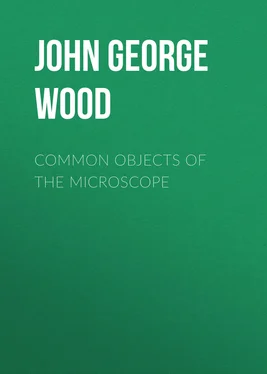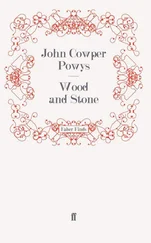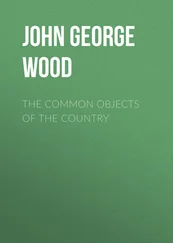John George Wood - Common Objects of the Microscope
Здесь есть возможность читать онлайн «John George Wood - Common Objects of the Microscope» — ознакомительный отрывок электронной книги совершенно бесплатно, а после прочтения отрывка купить полную версию. В некоторых случаях можно слушать аудио, скачать через торрент в формате fb2 и присутствует краткое содержание. Жанр: foreign_prose, foreign_antique, на английском языке. Описание произведения, (предисловие) а так же отзывы посетителей доступны на портале библиотеки ЛибКат.
- Название:Common Objects of the Microscope
- Автор:
- Жанр:
- Год:неизвестен
- ISBN:нет данных
- Рейтинг книги:4 / 5. Голосов: 1
-
Избранное:Добавить в избранное
- Отзывы:
-
Ваша оценка:
- 80
- 1
- 2
- 3
- 4
- 5
Common Objects of the Microscope: краткое содержание, описание и аннотация
Предлагаем к чтению аннотацию, описание, краткое содержание или предисловие (зависит от того, что написал сам автор книги «Common Objects of the Microscope»). Если вы не нашли необходимую информацию о книге — напишите в комментариях, мы постараемся отыскать её.
Common Objects of the Microscope — читать онлайн ознакомительный отрывок
Ниже представлен текст книги, разбитый по страницам. Система сохранения места последней прочитанной страницы, позволяет с удобством читать онлайн бесплатно книгу «Common Objects of the Microscope», без необходимости каждый раз заново искать на чём Вы остановились. Поставьте закладку, и сможете в любой момент перейти на страницу, на которой закончили чтение.
Интервал:
Закладка:
A less marked example of stellate tissue is given in Fig. 11, where the cells are extremely irregular, in their form, and do not coalesce throughout. This specimen is taken from the pithy part of a bulrush. There are very many other plants from which the stellate cells may be obtained, among which the orange affords very good examples, in the so-called “white” that lies under the yellow rind, a section of which may be made with a very sharp razor, and placed in the field of the microscope.
Looking toward the bottom of the Plate, and referring to Fig. 27, the reader will observe a series of nine elongated cells, placed end to end, and dotted profusely with chlorophyll. These are obtained from the stalk of the common chickweed. Another example of the elongated cell is seen in Fig. 14, which is a magnified representation of the rootlets of wheat. Here the cells will be seen set end to end, and each containing its nucleus. On the left hand of the rootlet (Fig. 13) is a group of cells taken from the lowest part of the stem of a wheat plant which had been watered with a solution of carmine, and had taken up a considerable amount of the colouring substance. Many experiments on this subject were made by the Rev. Lord S. G. Osborne, and may be seen at full length in the pages of the Microscopical Journal , the subject being too large to receive proper treatment in the very limited space which can here be given to it. It must be added that later researches have caused the results here described to be gravely disputed.
Fig. 9on the same Plate exhibits two notable peculiarities—the irregularity of the cells and the copiously pitted deposit with which they are covered. The irregularity of the cells is mostly produced by the way in which the multiplication takes place, namely, by division of the original cell into two or more new ones, so that each of these takes the shape which it assumed when a component part of the parent cell. In this case the cells are necessarily very irregular, and when they are compressed from all sides they form solid figures of many sides, which, when cut through, present a flat surface marked with a variety of irregular outlines. This specimen is taken from the rind of a gourd.
The “pitted” structure which is so well shown in this figure is caused by a layer of matter which is deposited in the cell and thickens its walls, and which is perforated with a number of very minute holes called “pits.” This substance is called “secondary deposit.” That these pits do not extend through the real cell-wall has already been shown in Fig. 12.
This secondary deposit assumes various forms. In some cases it is deposited in rings round the cell, and is clearly placed there for the purpose of strengthening the general structure. Such an example may be found in the mistletoe (Fig. 5), where the secondary deposit has formed itself into clear and bold rings that evidently give considerable strength to the delicate walls which they support. Fig. 10shows another good instance of similar structure; differing from the preceding specimen in being much longer and containing a greater number of rings. This object is taken from an anther of the narcissus. Among the many plants from which similar objects may be obtained, the yew is perhaps one of the most prolific, as ringed wood-cells are abundant in its formation, and probably aid greatly in giving to the wood the strength and elasticity which have long made it so valuable in the manufacture of bows.
Before taking leave of the cells and their remarkable forms, we will just notice one example which has been drawn in Fig. 6. This is a congeries of cells, containing their nuclei, starting originally end to end, but swelling and dividing at the top. This is a very young group of cells (a young hair, in fact) from the inner part of a lilac bud, and is here introduced for the purpose of showing the great similarity of all vegetable cells in their earliest stages of existence.
Having now examined the principal forms of cells, we arrive at the “vessels,” a term which is applied to those long and delicate tubes which are formed of a number of cells set end to end, their walls of separation being absorbed.
In Fig. 19the reader will find a curious example of the “pitted vessel,” so called from the multitude of little markings which cover its walls, and are arranged in a spiral order. Like the pits and rings already mentioned, the dots are composed of secondary deposit in the interior of the tube, and vary very greatly in number, function, and dimensions. This example is taken from the wood of the willow, and is remarkable for the extreme closeness with which the dots are packed together.
Immediately on the right hand of the preceding figure may be seen another example of a dotted vessel (Fig. 20), taken from a wheat stem. In this instance the cells are not nearly so long, but are wider than in the preceding example, and are marked in much the same way with a spiral series of dots. About the middle of the topmost cell is shown the short branch by which it communicates with the neighbouring vessel.
Fig. 23exhibits a vessel taken from the common carrot, in which the secondary deposit is placed in such a manner as to resemble a net of irregular meshes wrapped tightly round the vessel. For this reason it is termed a “netted vessel.” A very curious instance of these structures is given in Fig. 26, at the bottom of the Plate, where are represented two small vessels from the wood of the elm. One of them—that on the left hand—is wholly marked with spiral deposit, the turns being complete; while, in the other instance, the spiral is comparatively imperfect, and the cell-walls are marked with pits. If the reader would like to examine these structures more attentively, he will find plenty of them in many familiar garden vegetables, such as the common radish, which is very prolific in these interesting portions of vegetable nature.
There is another remarkable form in which this secondary deposit is sometimes arranged that is well worthy of our notice. An example of this structure is given in Fig. 18, taken from the stalk of the common fern or brake. It is also found in very great perfection in the vine. On inspecting the illustration, the reader will observe that the deposit is arranged in successive bars or steps, like those of a winding staircase. In allusion to the ladder-like appearance of this formation, it is called “scalariform” (Latin, scala , a ladder).
In the wood of the yew, to which allusion has already been made, there is a very peculiar structure, a series of pits found only in those trees that bear cones, and therefore termed the coniferous pitted structure. Fig. 16is a section of a common cedar pencil, the wood, however, not being that of the true cedar, but of a species of fragrant Juniper. This specimen shows the peculiar formation which has just been mentioned.
Any piece of deal or pine will exhibit the same peculiarities in a very marked manner, as is seen in Fig. 24. A specimen may be readily obtained by making a very thin shaving with a sharp plane. In this example the deposit has taken a partially spiral form, and the numerous circular pits with which it is marked are only in single rows. In several other specimens of coniferous woods, such as the Araucaria, or Norfolk Island pine, there are two or three rows of pits.
A peculiarly elegant example of this spiral deposit may be seen in the wood of the common yew (Fig. 17). If an exceedingly thin section of this wood be made, the very remarkable appearance will be shown which is exhibited in the illustration. The deposit has not only assumed the perfectly spiral form, but there are two complete spirals, arranged at some little distance from each other, and producing a very pretty effect when seen through a good lens.
The pointed, elongated shape of the wood-cells is very well shown in the common elder-tree (see Fig. 15). In this instance the cells are without markings, but in general they are dotted like Fig. 21, an example cut from the woody part of the chrysanthemum stalk. This affords a very good instance of the wood-cell, as its length is considerable, and both ends are perfect in shape. On the right hand of the figure is a drawing of the wood-cell found in the lime-tree (Fig. 22), remarkable for the extremely delicate spiral markings with which it is adorned. In these wood-cells the secondary deposit is so plentiful that the original membranous character of the cell-walls is entirely lost, and they become elongated and nearly solid cases, having but a very small cavity in their centre. It is to this deposit that the hardness of wood is owing, and the reader will easily see the reason why the old wood is so much harder than the young and new shoots. In order to permit the passage of the fluids which maintain the life of the part, it is needful that the cell-wall be left thin and permeable in certain places, and this object is attained either by the “pits” described on page 43
Читать дальшеИнтервал:
Закладка:
Похожие книги на «Common Objects of the Microscope»
Представляем Вашему вниманию похожие книги на «Common Objects of the Microscope» списком для выбора. Мы отобрали схожую по названию и смыслу литературу в надежде предоставить читателям больше вариантов отыскать новые, интересные, ещё непрочитанные произведения.
Обсуждение, отзывы о книге «Common Objects of the Microscope» и просто собственные мнения читателей. Оставьте ваши комментарии, напишите, что Вы думаете о произведении, его смысле или главных героях. Укажите что конкретно понравилось, а что нет, и почему Вы так считаете.












